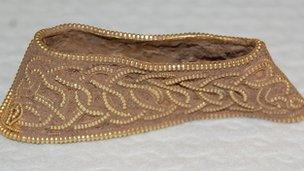Secrets of the Staffordshire Hoard explored in TV show
- Published
Since it was discovered by a metal detector enthusiast in 2009, the Staffordshire Hoard has captured peoples' imaginations.
Over 3,500 pieces of Anglo-Saxon treasure were discovered in a farmer's field and the quest to try and work out the mystery of how and why it ended up there began.
A new BBC TV programme, hosted by historian Dan Snow, tries to unravel the secrets of the hoard.
Could it be the spoils of war, looted treasure from long ago battles?
Or gifts given as tributes to a Mercian king?
Mysteries of hoard
Professor Simon Keynes, an Anglo-Saxon expert from the University of Cambridge, said it appeared most likely that it was "some kind of treasure that has been recovered from a battlefield".

Thousands of items were found buried
Marion Blockley, an archaeologist, wonders if there is a clue in a lament written in around the 9th Century that describes a 7th Century battle and raid in the Midlands.
Did warriors ransack a settlement and leave with captured treasure?
"It's possible as they fled that they may have taken the hoard with them and buried it, hoping to come back but sadly they were killed," Ms Blockley said.
"I'm not saying it's true, but you know, it may well be."
'Significant items'
The Staffordshire Hoard is made up of thousands of items, including pieces of weaponry and dozens of ornate sword pommels, so could they have been part of a king's collection that had somehow fallen into the wrong hands?
Ms Blockley said nearby Tamworth had been a royal treasury.
She said kings used to receive gifts of "significant items of weaponry" which they would then redistribute to their favourite warriors.
Some say a key part of solving the mystery of the hoard could lie in where it was found near what was an important route between the Midlands and London, Watling Street.

Conservation work has been carried out on the artefacts
Landscape specialist Dr Della Hook said there were a number of theories.
She said the treasures could "just have been pushed into a hole near a hillock which would be recognisable again by someone fleeing along Watling Street".
Another suggestion, she said, was that it could have been deliberately placed there, as a sort of "votive offering".
"Ill-gotten gains had to buried and it's just possible it was buried there... as a magical ritual," Dr Hook added.
Work to reveal the mysteries of the hoard continues.
Kevin Leahy, national finds advisor from the portable antiquities scheme, said: "It's not the objects you identify straightaway that are going to give us the story, it's the things that we don't know what they are."
- Published29 October 2011
- Published3 July 2011
- Published16 April 2011